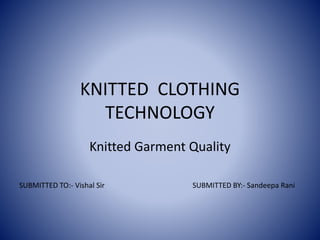KNITTED GARMENT TECNH
- 1. KNITTED CLOTHING TECHNOLOGY Knitted Garment Quality SUBMITTED BY:- Sandeepa RaniSUBMITTED TO:- Vishal Sir
- 2. KNITTED GARMENT QUALITY âĒ The quality of a knitted garment reflects all the processes through which the various components have passed during its manufacture. âĒ Knitted fabrics has already been discussed and the problems of quality outlined. âĒ Faults incurred during the knitting and fabric processes pass on into the knitted garment itself unless detected an diverted.
- 3. Requirements âĒ The Quality System Requirements are based on the principle of PDCA Cycle. Process Cycle
- 4. Process Cycle âĒ Understanding the customers' quality requirements. âĒ Organizing & training quality control department. âĒ Ensuring proper flow of quality requirements to the QC department. âĒ Ensuring proper flow of quality requirements to the Production Department. âĒ Establishing quality plans, parameters, inspection systems, frequency, sampling techniques, etc.. âĒ Inspection, testing, measurements as per plan. âĒ Record deviations âĒ Feed back to Production Department. âĒ Plan for further improvement.
- 5. Establishing the Quality Requirements âĒ The first step for quality control is to understand, establish & accept the customers' quality requirements. This involves the following steps. âĒ Getting customers specifications regarding the quality âĒ Referring our past performance âĒ Discussing with the Quality Control Department âĒ Discussing with the Production Department âĒ Giving the Feed Back to the customers âĒ Receiving the revised quality requirements from the customers âĒ Accepting the quality parameters
- 6. Various Steps of Inspection & Quality Control âĒ The following levels are discussed at the Garment Making Department assuming that this department is receiving the ready to cut dyed & finished fabrics from the Dyeing & Finishing Department.
- 7. Before or Pre-production Inspection âĒ The following parameters & defects are checked prior to cutting. âĒ Shade Matching âĒ Fabric Construction âĒ GSM (grams per square metre) âĒ Whales & courses if required) âĒ Diameter âĒ Dyeing Levelness âĒ Ecological parameters if required âĒ Softness âĒ Shrinkage âĒ Matching of Rib, Collars & Cuffs âĒ Fabric Holes âĒ Vertical & Horizontal Stripes âĒ Knitting defects such as missing loops, sinker lines, etc. âĒ Bowing âĒ Skewing âĒ Yarn defects such as thick & thin places
- 8. During Production Inspection âĒ Verify cutting patterns âĒ Cut components measurements âĒ Cutting shapes âĒ Fabric defects âĒ Other specific parameters as required by the customers Rib, Collars & Cuffs matching âĒ Stitching defects âĒ Sewing threads matching âĒ Dirts & Stains âĒ Measurements âĒ Labels âĒ Trims & Accessories
- 9. Before Production Inspection âĒ Many of the important parameters of Pre- productions, During productions & Final inspection parameters. This is to ensure that wrong or major defective garments are not packed.
- 10. Final Inspection âĒ A. PACKING & ASSORTMENT âĒ Wrong Model âĒ Wrong Quantity âĒ Missing labels & tags âĒ Wrong Size & Colour assortment âĒ Wrong Folding âĒ B. FABRIC DEFECTS âĒ Wrong Shade âĒ Uneven dyeing âĒ Holes âĒ Knitting stripes âĒ Thick & Thin places âĒ Dirt & Stains âĒ Oil stains âĒ Sinker line âĒ Poor softness âĒ Higher Shrinkage âĒ Crease Marks
- 11. âĒ C. WORKMANSHIP DEFECTS âĒ Open seam âĒ Puckering âĒ Needle holes & marks âĒ Unbalanced sleeve edge âĒ Unbalanced placket âĒ Insecure shoulder stitch âĒ Incorrect side shape âĒ Bottom hem bowing âĒ Uneven neck shape âĒ Cross labels âĒ Broken & Missing stitch âĒ Insecured buttons âĒ Untrimmed threads & fabrics âĒ Poor Ironing âĒ Double stitch
- 12. âĒ D. GENERAL DEFECTS âĒ Shade variation within the garment parts âĒ Shade variation between the garments âĒ Defective printing âĒ Defective embroidery âĒ Defective buttons âĒ E. MEASUREMENT DEVIATIONS âĒ Compare the garment measurements against the Customers' Measurement Charts. âĒ Following are the some of the important garments' measurement aspects to be considered. âĒ Garment length âĒ Body width âĒ Shoulder length âĒ Arm hole âĒ Arm Opening âĒ Sleeve length âĒ Placket length âĒ Placket width âĒ Neck width âĒ Neck opening âĒ Hemming width âĒ IRib or Collar width












